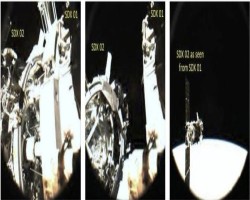UPSC Current Affairs
TABLE OF CONTENTS |
| Science and Technology |
|---|
|
|
|
Why in News?
The Indian Space Research Organisation (ISRO) successfully undocked the two satellites of the Space Docking Experiment (SpaDeX) mission on March 14, 2025. This marks a significant achievement for India's space capabilities, following the successful docking of the satellites on January 16, 2025. What is the SpaDeX Mission? About: SpaDeX (Space Docking Experiment) is an advanced mission by ISRO aimed at developing and demonstrating in-orbit rendezvous, docking, and undocking technology. It involves two small satellites, SDX01 (Chaser) and SDX02 (Target), launched aboard the PSLV C60 on December 30, 2024. India became the fourth country, after the U.S., Russia, and China, to achieve satellite docking in orbit. Key Operations: The undocking occurred at 9:20 a.m. IST in a 460 km circular orbit with a 45-degree inclination. The satellites are now orbiting independently, and their health remains normal, as confirmed by ISRO. The operation was monitored through ground stations in Bengaluru, Lucknow, and Mauritius. ISRO performed extensive ground simulations before executing the undocking maneuver successfully in its first attempt. Significance of the SpaDeX Mission Rendezvous and Docking Capabilities: Demonstrating docking and undocking is crucial for various future space missions, including human spaceflight. In-Space Servicing and Assembly: The mission supports advancements in space robotics, repair, and assembly of spacecraft in orbit. Technology for Future Missions: The docking and undocking capability is essential for future endeavors like: Sending an Indian astronaut to the Moon. Lunar and planetary sample return missions. Development of an Indian Space Station. Power Transfer Demonstration: The mission also aims to test the transfer of electrical power between docked spacecraft, which is essential for deep-space exploration and in-orbit servicing missions. What’s Next? ISRO has planned further experiments with the undocked satellites in the coming days. The success of SpaDeX paves the way for India's upcoming ambitious space missions, strengthening its presence in global space exploration. Do You Know? ISRO’s achievement in docking places India in an elite league alongside the U.S., Russia, and China. India is also planning the Gaganyaan Mission, its first human spaceflight mission, which will benefit from the docking technology demonstrated in SpaDeX. The concept of in-orbit docking is widely used in assembling and maintaining space stations, such as the International Space Station (ISS). Way Forward Human Spaceflight Readiness: SpaDeX’s success is a step toward India’s upcoming human spaceflight and space station initiatives. Advancing Space Technology: ISRO will continue to refine docking mechanisms for future deep-space and interplanetary missions. International Collaboration: The technology opens avenues for collaborations in joint space station ventures and in-orbit servicing missions. With SpaDeX’s success, India has taken another significant leap in space exploration, further solidifying its capabilities in advanced space technologies and paving the way for future ambitious missions. |
|
|
|
About Indian Space Research Organisation (ISRO):
Formed: 15 August 1969 Preceding agency: INCOSPAR (1962–1969) Headquarters: Bengaluru, Karnataka Chairman: V Narayanan (11th Chairman of the Indian Space Research Organisation) Primary spaceports: Satish Dhawan Space Centre, Thumba Equatorial Rocket Launching Station, Kulasekarapattinam Spaceport |
|
<< 13-Mar-25
|
|
|
